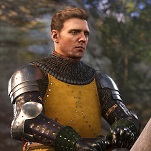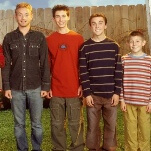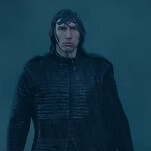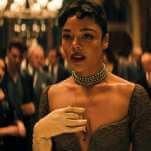While it is no longer accurate to call The Puma Blues a truly lost work in the same manner as, say, Alan Moore’s Big Numbers, it certainly came uncomfortably close to a similar oblivion. Miraculously complete it returned, however, at the tail end of 2015, a strange artifact from another era. Now that it’s back, a bit of explanation is in order.
In 1986 nobody had ever heard of Michael Zulli or Stephen Murphy. Dave Sim (of Cerebus fame) knew the moment he saw Zulli’s work that Zulli would be a star, and so resolved to become his first publisher. Up to that point Zulli and Murphy were just two New England comics fans, but the moment the first issue of The Puma Blues saw print in 1986, it was obvious that both men would go on to have long and prolific careers in the world of comics. And that’s what happened, even if The Puma Blues itself fell by the wayside.
The original run of The Puma Blues lasted from 1986 to 1989. Sim published the first 19 issues, even after the series fell victim to an ongoing dispute between Sim and his distributor. Kevin Eastman and Peter Laird’s Mirage Studios picked up the reins after that for a few issues, but the series ended three issues shy of its projected conclusion. Zulli went on to illustrate issue #13 of The Sandman – that’s the first one with William Shakespeare – among other things. Murphy went to work on Eastman and Laird’s Teenage Mutant Ninja Turtles, both as a creator on multiple iterations of the TMNT comic book and later behind the scenes involved in creative and marketing at Mirage. The Puma Blues receded further into the background, a cult object that looked most likely to remain forever unfinished.
Now The Puma Blues has finally been completed, and compiled between two covers by the new MVP of archival comics presentation, Dover Publications. It seems almost lazy to call the work sui generis, but nothing really serves to adequately summarize such a surpassingly odd but also supremely affecting work. While the work begins as a near-future sci-fi story—set in the far-flung future of 1997!—it eventually grows to encompass pseudo-autobiography, New Age mysticism, conspiracy literature, UFO-logy, and natural history. More than anything else, the book is an environmental fable, and even though some of the ecological particulars have changed in the ensuing 30 years, the overall attitude of planetary urgency, tinged with anti-government paranoia, remains an all-too current sensation.
The Puma Blues is one of those books that could only exist in comics, a highly personal tour de force by two artists still too young to understand the preposterousness of such a doggedly uncommercial enterprise. It’s gorgeous. Dover’s hardcover edition, weighing in at 560 pages and four-and-a-half pounds, is an intimidating package. There’s an extended introduction by Sim, an extended afterward by Stephen Bissette, and a rare four-page story by Alan Moore. Plus, of course, the brand new 40-page conclusion by Murphy and Zulli. Now that it’s done The Puma Blues can take its rightful place alongside the period’s other great monuments, such as Moore and Campbell’s From Hell and Gaiman’s Sandman. Without it, any well-stocked comics library should be considered incomplete. [Tim O’Neil]
Although
Fables ended last year to no small amount of fanfare, the characters that Bill Willingham created and shepherded for over a decade still live on in more than just the hearts and minds of fans. Set prior to the events of the main
Fables comics,
Fables: The Wolf Among Us #13 (Vertigo) comes closer to the end of a whodunnit story than the beginning. After several murders rock Fabletown and specifically his beloved Snow White, Bigby Wolf has been investigating the deaths. By this point, he’s figured out who the perpetrator is and been forced to release them into the clutches of a bigger, meaner bad guy. It’s becoming clear just how foundational this experience is to Bigby, Snow, and Fabletown, and just how much this old hurt has informed their relationship later on. It’s a neat insight into two already familiar and well liked characters.
Writers Dave Justus and Matt Sturges do a great job with a limited plot: Not only are they playing in somebody else’s sandbox, but they’re doing so with every major story point already mapped out for them. In 2013, Fables: The Wolf Among Us was released by Telltale games, capitalizing on the success of similar games based on The Walking Dead. Last year, Vertigo began publishing the digital-first comic based on the game, a sort of matroshka doll of mediums. Sturges has worked on a slew of Vertigo and DC titles before, but he and Justus have collaborated on Public Relations and briefly House Of Mysteries; they’re a strong writing team with a great sense of humor that includes not-so-veiled references to the best John Mulaney joke ever.
Like a some other books flying too far under the radar, The Wolf Among Us suffers from inconsistent and many artists from issue to issue. Eric Nguyen has a sketchy, jagged style that’s particularly well suited for the fight scene that opens up the book. Megan Levens has a cleaner, more cartoonish style, but her Bigby in particular feels off, more like the pretty, slender love child of John Constantine and Sam Winchester than a wolf in man’s clothing. Travis Moore has worked on nearly every issue of The Wolf Among Us, but he’s only responsible for the back third of #13. He’s got a strong handle on all of the characters, with solid expression work and dynamic backgrounds that add a lot of depth, particularly important for a world like Fabletown where the setting becomes a character in its own right.
Being a digital-first title, the pages are clearly meant to be read on a tablet or computer, each half of the page distinct, and it’s a strange effect in print; only Moore has full-page designs. The unifying element is Lee Loughridge’s strong coloring. Though there is a clear, intentional color palette for the book, it’s less monochromatic than his work on titles like Southern Cross and Wolf, and the choice eschew black and flatten the shading when the characters move to the mirror-universe called the Silverling makes those pages suitably unsettling.
With little marketing support and glut of new offerings from publishers like Image that have elbowed into Vertigo’s niche, this book isn’t attracting nearly enough attention. It’s still a fun ride for hardcore Fables fans and those who enjoyed the video game, a good mystery that is well worth checking out. [Caitlin Rosberg]
A memoir of the days following the death of his 2-year-old daughter, Tom Hart’s
Rosalie Lightning (St. Martin’s Press) attempts to replicate for the reader the emotions it’s depicting. To accomplish this, Hart pushes and pulls the reader, dragging them backwards and forwards in time; from one panel to the next he cuts back and forth between the past and the diegetic present. Immense sadness is bracketed by saccharine joys, and the effect is disorientation.
The way Rosalie Lightning approaches time is particularly interesting. The book isn’t atemporal, but it disregards nearly all but the most indexical signifiers of time and temporal relationships. This stylistic choice forces the reader to constantly reorient themselves—moments that seem temporally contiguous are actually separated by weeks, months, years, and vice versa. The effect is an entropic instability and it’s difficult to get a strong foothold on the story. While often a detriment, that ambiguous mode serves this particular narrative well, and that slippery, elusive quality approximates (however vaguely) the powerful confusion that Hart and his wife were experiencing. You not only get a strong sense of their loss, but you are constantly grasping at some stabilizing force.
This oblique detailing of emotions is important because Hart largely spends the book, and the events of the book, avoiding confronting his feelings. He tells one therapist that writing and drawing are his equivalent of growing 50 feet tall and smashing mountains until he feels better, and Rosalie Lightning’s role as a cathartic object-event is made clear in the way Hart avoids drawing faces. He avoids confronting the subject matter too overtly or conventionally. While the inability to vivisect your past and proudly display it would normally defang a memoir, Hart has the advantage of not working in prose. Comics allows him to combine text with images, which gives him the space to craft something both unsaid and explicit. He can dance around a thing without there being any equivocation regarding the nature of that thing.
Alternating between the stripped-down style of a picture book and the lurid, inky line of an EC horror comic (and a number of other pastiches), Hart displays the versatility of his pen and delivers some of his most audacious cartooning. The disparate aesthetics are unified by the shared use of screen tone, which recontextualizes Hart’s pages within the simple and deeply personal milieu of zine-making. The whole thing, down to these little details, is nakedly personal, honest, and raw. It’s a dust-jacket hardcover from a major book publisher, but it’s wearing the clothes of a teenager’s mini-comic—to great affect. This affect, however, is double-edged. The ending of Rosalie Lightning is its weakest link, and the same touch that imbued the book with intense pathos is the same one that leads to the sequence of false endings. There are several wonderfully poignant moments that Hart could have ended on, but he chooses not to. He reiterates and recapitulates the drama of the book again and again, unable to say goodbye for the same reason he was able to create it in the same place. [Shea Hennum]
During his 25 years as publisher at Drawn & Quarterly, Chris Oliveros turned his small company into one of the major forces in the comic-book industry, helping to usher in a new era of critical and commercial appreciation for the art form. He cultivated a remarkable line-up of talent at D&Q (which you can learn more about in the phenomenal
D&Q 25th anniversary hardcover), and his time spent examining the medium from a management position sharpened his skills as a cartoonist. Oliveros stepped down from the publisher position last year to focus on creating his own comics, and his graphic novel debut,
The Envelope Manufacturer (self-published), reveals Oliveros’ talent for alienating the reader through the relationship of art.
Alienation may not sound like a good thing, but it’s an essential aspect of Oliveros’ story, which focuses on how Jack, the owner of a struggling envelope manufacturing company, becomes increasingly disconnected from the people around him and reality at large. The focus of the artwork is often distanced from the action represented by the text, with the panels showing stationary objects or environmental landmarks while word balloons indicate events happening elsewhere. This can make for a frustrating reading experience, particularly when the text is describing moments that aren’t being shown in the artwork, but that frustration is intentional and reflective of Jack’s increasing aggravation with the financial situation of his company.
While the time period isn’t firmly established in the story, the design places it somewhere in the late ’50s/early ’60s, a time just before major changes starting occurring both culturally and industrially. Jack and his company are on the verge of becoming obsolete, and Jack’s mental reaction is a severe break from reality. Oliveros is constantly showing the machinery in the office without revealing the function of these devices, which is an effective way of indicating their archaic nature. Are these even machines used in creating envelopes? Most of them are just junk, but Oliveros’ focus on them reveals the importance of these pieces of junk in Jack and his employees’ lives.
The Envelope Manufacturer is an unsettling read due to Oliveros’ reluctance to clarify what is real and what is imagined, and his tendency to move away from the action to highlight areas of the surround environment plays a big part in that. The attention of the visuals is scattered, but the intent of the artist is confident and direct, forcing distance between the reader and the action to create an atmosphere of discomfort. It’s not the easiest read, but the challenge is what makes it rewarding, and the complex relationship between words and images reveals the depth of Oliveros’ understanding of the medium. [Oliver Sava]







































